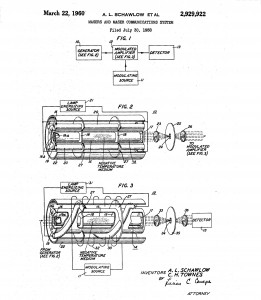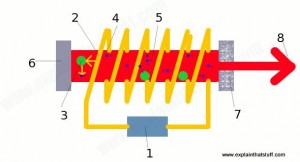If the name maser doesn’t ring a bell, maybe laser will.
The first working laser was reported in 1960 and described as “a solution looking for a problem.”
“Today, lasers are everywhere: from research laboratories at the cutting edge of quantum physics to medical clinics, supermarket checkouts and the telephone network.” (The First Laser, Charles H. Townes from A Century of Nature: Twenty-One Discoveries that Changed Science and the World.)
 March 22 marked the day in 1960 when Arthur L Schawlow and Charles H. Townes were granted US Patent 292922 for the maser which is now known as the Laser.
March 22 marked the day in 1960 when Arthur L Schawlow and Charles H. Townes were granted US Patent 292922 for the maser which is now known as the Laser.
But, before thoughts of an Obi-wan Kenobi/Darth Vader duel dance in your head, ponder this: it took more than a few Nobel prize winning physicists to study atoms doing a jig –to pave the path and forge into the future –with the light beams now known as lasers.
Explained, a Laser or, light amplification by stimulated emission of radiation are powerful light beams driven by energy (excited atoms) “that are capable of zooming miles into the sky or cutting through chunks of metal”
According to explainthatstuff.com:
A laser is effectively a machine that makes billions of atoms pump out trillions of photons (light particles) all at once so they line up to form a really concentrated light beam.
A red laser contains a long crystal made of ruby (shown here as a red bar) with a flash tube (yellow zig-zag lines) wrapped around it. The flash tube looks a bit like a fluorescent strip light, only it’s coiled around the ruby crystal and it flashes every so often like a camera’s flash gun.
How do the flash tube and the crystal make laser light?
- A high-voltage electric supply makes the tube flash on and off.
- Every time the tube flashes, it “pumps” energy into the ruby crystal. The flashes it makes inject energy into the crystal in the form of photons.
- Atoms in the ruby crystal (large green blobs) soak up this energy in a process called absorption. When an atom absorbs a photon of energy, one of its electrons jumps from a low energy level to a higher one. This puts the atom into an excited state, but makes it unstable. Because the excited atom is unstable, the electron can stay in the higher energy level only for a few milliseconds. It falls back to its original level, giving off the energy it absorbed as a new photon of light radiation (small blue blob). This process is called spontaneous emission.
- The photons that atoms give off zoom up and down inside the ruby crystal, traveling at the speed of light.
- Every so often, one of these photons hits an already excited atom. When this happens, the excited atom gives off two photons of light instead of one. This is called stimulated emission. Now one photon of light has produced two, so the light has been amplified (increased in strength). In other words, “light amplification” (an increase in the amount of light) has been caused by “stimulated emission of radiation” (hence the name “laser”, because that’s exactly how a laser works!)
- A mirror at one end of the laser tube keeps the photons bouncing back and forth inside the crystal.
- A partial mirror at the other end of the tube bounces some photons back into the crystal but lets some escape.
- The escaping photons form a very concentrated beam of powerful laser light.
Just how did all this start?
“Light amplification by stimulated emission of radiation” or “laser” was first known as the maser: microwave amplification by stimulation emission of radiation and, Charles Hard Townes is credited with conceiving the idea while sitting on a park bench on April 26, 1951.
His work with brother-in-law, physicist Arthur L. Schawlow led to the invention of many of the things (most of us) may view as inconceivable to have to live without:
microwaves, music, telephones … and, let’s not forget to mention the bar code scanner which, without those, there’s no telling just how long we might have to wait in a Walmart line.
But first, the history leading up to microwave amplification by stimulation emission of radiation (maser) dates back to 1900 when, Max Planck “deduced the relationship between energy and the frequency of radiation, essentially saying that energy could be emitted or absorbed only in discrete chunks – which he called quanta – even if the chunks were very small.” – photonics.com
It is thought that Planck’s theory “marked a turning point in physics and inspired up-and-coming physicists such as Albert Einstein.” – national-laser.com
- In 1905, Einstein released his paper on the photoelectric effect.
- In 1917, Einstein proposed the process that makes lasers possible called “stimulated emission.”
- In 1918, Planck received the Nobel Prize in physics.
Some forty years later, Einstein’s theory was proven correct when scientists were finally able to amplify those emissions “putting lasers on the path to becoming the powerful and ubiquitous tools they are today.”
Meanwhile (and back at Bell labs) “Townes had hired Schawlow for a postdoctoral project involving the application of microwave spectroscopy to organic chemistry. Schawlow didn’t care much for organic chemistry, but he knew something about microwaves from his wartime work on radar. He measured nuclear quadruple moments and, with Townes, studied the effect of nuclear charge distribution on X-ray fine structure.
“I’ve never been a real theorist,” Schawlow once said, “but strangely enough I think several of my best papers have been theoretical.” He explained that he was able to look at the subject with fresh eyes and explain it with a minimum of mathematics.” – osa-opn.org
It was through their collaboration on a book, Microwave Spectroscopy, that Schawlow met Aurelia, Townes’ sister. The two married less than a year later.
According to “Credible (and Edible) Lasers: The Life of Arthur L. Schawlow” by Patricia Daukantas:
“On weekends Schawlow got together with his brother-in-law to finish writing their spectroscopy book, which McGraw-Hill published in 1955. Townes was the first and senior author, but the book boosted Schawlow’s reputation as well.”
“While Townes and Schawlow were eating lunch at Bell Labs one day in October 1957, they found they had both been thinking independently about ways to make masers at shorter wavelengths, going into the infrared, so they agreed to work together.”
Schawlow and Townes first filed for their patent on July 30, 1958, but the rest of the story becomes a little less like a Star Wars trilogy and more of a candy store caper when Columbia grad student, Gordon Gould jotted his idea for building a laser and had it notarized at a candy store in the Bronx on November 13, 1957.
Schawlow and Townes were granted the patent which led to a 30 year patent dispute over the invention of the laser.
And Gould wasn’t the only one: by 1961, Lasers begin appearing on the commercial market through companies such as Trion Instruments Inc., Perkin-Elmer and Spectra-Physics.
Interestingly, the world’s first experiment firing a laser beam into a tropical storm occurred on September 11, 1994 – nytimes.com – twenty years after the debut of Star Wars and the lightsaber duel.
When the first working laser was reported in 1960, it was described as “a solution looking for a problem.” But before long the laser’s distinctive qualities—its ability to generate an intense, very narrow beam of light of a single wavelength—were being harnessed for science, technology and medicine. Today, lasers are everywhere: from research laboratories at the cutting edge of quantum physics to medical clinics, supermarket checkouts and the telephone network. – The First Laser, Charles H. Townes from A Century of Nature: Twenty-One Discoveries that Changed Science and the World. – nobelprize.org

